
French assistance to Nguyen Anh
Encyclopedia
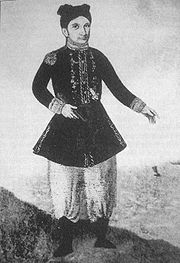
French assistance to Nguyễn Ánh, the future Emperor of Vietnam Gia Long
Gia Long
Emperor Gia Long , born Nguyễn Phúc Ánh , was an emperor of Vietnam...
, founder of the Nguyễn Dynasty, covered a period from 1777 to 1820. From 1777, Mgr Pigneau de Behaine
Pigneau de Behaine
Pierre Joseph Georges Pigneau , commonly known as Pigneau de Béhaine, also Pierre Pigneaux and Bá Đa Lộc , was a French Catholic priest best known for his role in assisting Nguyễn Ánh to establish the Nguyễn Dynasty in Vietnam after the Tây Sơn...
, of the Paris Foreign Missions Society
Paris Foreign Missions Society
The Society of Foreign Missions of Paris is a Roman Catholic missionary organization. It is not a religious order, but an organization of secular priests and lay persons dedicated to missionary work in foreign lands....
, had taken to protecting the young Vietnamese prince who was fleeing from the offensive of the Tây Sơn. Pigneau de Behaine went to France to obtain military aid, and obtained that a France-Vietnam alliance was signed through the 1787 Treaty of Versailles
Treaty of Versailles (1787)
The Versailles Treaty of 1787 was a treaty of alliance signed between the French king Louis XVI and the Vietnamese Prince Nguyễn Ánh, the future Emperor Gia Long....
, between the king of France Louis XVI and Prince Nguyễn Ánh. As the French regime was under considerable strain at the eve of the French Revolution
French Revolution
The French Revolution , sometimes distinguished as the 'Great French Revolution' , was a period of radical social and political upheaval in France and Europe. The absolute monarchy that had ruled France for centuries collapsed in three years...
, France was unable to follow through with the application of the treaty. However, Mgr Pigneau de Behaine persisted in his efforts and with the support of French individuals and traders mounted a force of French soldiers and officers that would contribute to the modernization of the armies of Nguyễn Ánh, contributing to his victory and his reconquest of the totality of Vietnam by 1802. A few French officers would remain in Vietnam after the victory, becoming prominent mandarins
Mandarin (bureaucrat)
A mandarin was a bureaucrat in imperial China, and also in the monarchist days of Vietnam where the system of Imperial examinations and scholar-bureaucrats was adopted under Chinese influence.-History and use of the term:...
. The last of them left in 1824, following the enthronement of Minh Mạng
Minh Mang
Minh Mạng was the second emperor of the Nguyễn Dynasty of Vietnam, reigning from 14 February 1820 until 20 January 1841. He was a younger son of Emperor Gia Long, whose eldest son, Crown Prince Canh, had died in 1801...
, Gia Long's successor. The terms of the 1787 Treaty of Alliance would still remain one of the justifications of French forces when they demanded the remittance of Đà Nẵng
Da Nang
Đà Nẵng , occasionally Danang, is a major port city in the South Central Coast of Vietnam, on the coast of the South China Sea at the mouth of the Han River. It is the commercial and educational center of Central Vietnam; its well-sheltered, easily accessible port and its location on the path of...
in 1847.
Protection of Nguyễn Ánh

Pigneau de Behaine
Pierre Joseph Georges Pigneau , commonly known as Pigneau de Béhaine, also Pierre Pigneaux and Bá Đa Lộc , was a French Catholic priest best known for his role in assisting Nguyễn Ánh to establish the Nguyễn Dynasty in Vietnam after the Tây Sơn...
in the southern Principality of Hà Tiên
Hà Tiên
Hà Tiên or Ha Tien is a town in Kien Giang Province, Tay Nam Bo of Vietnam. Area: 8,851.5 ha, population : 39,957. The town borders Cambodia to the west....
. Pigneau de Behaine and his Catholic community in Hà Tiên then helped Nguyễn Ánh take refuge in the island of Pulo Panjang.
These events created a strong bond between Nguyễn Ánh and Pigneau de Behaine, who took a role of protector over the young prince. Following this ordeal, Nguyễn Ánh was able to recapture Saigon in November 1777 and the whole of Cochinchina, and took the title of Commander in Chief in 1778.
Intervention in the Cambodian conflict (1799-1781)
In neighbouring CambodiaCambodia
Cambodia , officially known as the Kingdom of Cambodia, is a country located in the southern portion of the Indochina Peninsula in Southeast Asia...
, a pro-Cochinchinese revolt erupted to topple the pro-Siam king Ang Non. In 1780, the Cochinchinese troops of Nguyễn Ánh intervened, and Pigneau helped them obtain weapons from the Portuguese. The Bishop was even accused by the Portuguese of manufacturing weapons for the Cochinchinese, especially grenade
Grenade
A grenade is a small explosive device that is projected a safe distance away by its user. Soldiers called grenadiers specialize in the use of grenades. The term hand grenade refers any grenade designed to be hand thrown. Grenade Launchers are firearms designed to fire explosive projectile grenades...
s, a new weapon for Southeast Asia. Pigneau de Behaine also organized the supply of three Portuguese warships for Nguyễn Ánh. In his activities, Pigneau was supported by a French adventurer, Manuel. Contemporary witnesses clearly describe Pigneau's military role:
1782-1783-1785 Tây Sơn offensives
The French adventurer Manuel, in the service of Mgr Pigneau, took part in the battles against the 1782 offensive of the Tây Sơn. He fought commanding a warship against the Tây Sơn in the Saigon RiverSaigon River
The Saigon River is a river located in southern Vietnam that rises near Phum Daung in southeastern Cambodia, flows south and south-southeast for about 140 miles and empties into the Nha Be River, which in its turn empties into the South China Sea some 20 km north-east of the Mekong Delta.The...
, but he blew himself up with his warship rather than surrender to the more numerous Tây Sơn navy. In October 1782, Nguyễn Ánh was able to recapture Saigon, only to be expelled again by the Tây Sơn in March 1783.

Bangkok
Bangkok is the capital and largest urban area city in Thailand. It is known in Thai as Krung Thep Maha Nakhon or simply Krung Thep , meaning "city of angels." The full name of Bangkok is Krung Thep Mahanakhon Amon Rattanakosin Mahintharayutthaya Mahadilok Phop Noppharat Ratchathani Burirom...
end 1783. Nguyễn Ánh also reached Bangkok in February 1784, where he obtained that an army would accompany him back to Vietnam. In January 1785 however, the Siamese fleet met with disaster against the Tây Sơn in the Mekong.
Nguyễn Ánh again took refuge with the Siamese court, and again tried to obtain help from the Siamese. Nguyễn Ánh also resolved to obtain any help he could from Western countries. He asked Pigneau to appeal for French aid, and allowed Pigneau to take his five-year-old son Prince Cảnh with him. Pigneau also tried to obtain help from Manila
Manila
Manila is the capital of the Philippines. It is one of the sixteen cities forming Metro Manila.Manila is located on the eastern shores of Manila Bay and is bordered by Navotas and Caloocan to the north, Quezon City to the northeast, San Juan and Mandaluyong to the east, Makati on the southeast,...
, but the party of Dominicans he sent was captured by the Tây Sơn. From Pondicherry, he also sent a request for help to the Portuguese Senate in Macao
Mação
Mação is a municipality in Portugal with a total area of 400.0 km² and a total population of 7,763 inhabitants.The municipality is composed of eight parishes, and is located in the Santarém District....
, which would ultimately lead to the signature of a Treaty of Alliance between Nguyễn Ánh and the Portuguese on 18 December 1786 in Bangkok.
Treaty of Versailles (1787)
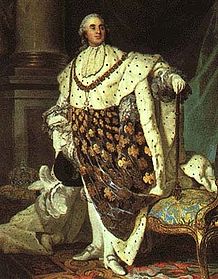
Marquis de Bussy-Castelnau
Charles Joseph Patissier, Marquis de Bussy-Castelnau was the Governor General of the French colony of Pondicherry from 1783 to 1785. He servied with distinction under Joseph François Dupleix in the East Indies, receiving the Order of Saint Louis...
, seconded by Captain d'Entrecasteaux
Bruni d'Entrecasteaux
Antoine Raymond Joseph de Bruni d'Entrecasteaux was a French navigator who explored the Australian coast in 1792 while seeking traces of the lost expedition of La Pérouse....
, was resolutely opposed to intervening in southern Vietnam, stating that it was not in the national interest. In July 1786, Pigneau was allowed to travel to France to ask the royal court directly for assistance. News of his activities reached Rome where he was denounced by the Spanish Franciscans, and offered Prince Cảnh and his political mandate to the Portuguese. They left Pondicherry for France in July 1786. which they reached in February 1787.

Louis XVI of France
Louis XVI was a Bourbon monarch who ruled as King of France and Navarre until 1791, and then as King of the French from 1791 to 1792, before being executed in 1793....
in Versailles
Versailles
Versailles , a city renowned for its château, the Palace of Versailles, was the de facto capital of the kingdom of France for over a century, from 1682 to 1789. It is now a wealthy suburb of Paris and remains an important administrative and judicial centre...
, Pigneau had difficulty in gathering support for a French expedition to install Nguyễn Ánh on the throne. This was due to the poor financial state of the country prior to the French Revolution
French Revolution
The French Revolution , sometimes distinguished as the 'Great French Revolution' , was a period of radical social and political upheaval in France and Europe. The absolute monarchy that had ruled France for centuries collapsed in three years...
.
Eventually, he was able to seduce the technicians of military action with his precise instructions as to the conditions of warfare in Indochina and the equipment for the proposed campaign. He explained how France would be able to "dominate the seas of China and of the archipelago." The party met with King Louis XVI, Minister of the Navy de Castries
Charles Eugène Gabriel de La Croix, marquis de Castries
Charles Eugène Gabriel de La Croix de Castries, marquis de Castries, baron des États de Languedoc, comte de Charlus, baron de Castelnau et de Montjouvent, seigneur de Puylaurens et de Lézignan was a French marshal...
and Minister of Foreign Affairs Montmorin
Armand Marc, comte de Montmorin
Armand Marc, comte de Montmorin de Saint Herem was a French statesman. He was Minister of Foreign Affairs and the Navy under Louis XVI....
on May 5 or 6, 1787. Prince Cảnh created a sensation at the court of Louis XVI, leading the famous hairdresser Léonard to create a hairstyle in his honour "au prince de Cochinchine". His portrait was made in France by Maupérin
Maupérin
Maupérin was a French painter of the 18th century for king Louis XVI.Maupérin was a painter of some reputation. On 31 December 1766, he obtained the third medal of the Académie Royale...
, and is now on display at the Séminaire des Missions Étrangères in Paris. Prince Cảnh dazzled the Court and even played with the son of Louis XVI, Louis-Joseph, Dauphin of France, who was about the same age.

Treaty of Versailles (1787)
The Versailles Treaty of 1787 was a treaty of alliance signed between the French king Louis XVI and the Vietnamese Prince Nguyễn Ánh, the future Emperor Gia Long....
was concluded between France and Cochin China in Nguyễn Ánh's name. Four frigates, 1650 fully equipped French soldiers and 250 Indian sepoy
Sepoy
A sepoy was formerly the designation given to an Indian soldier in the service of a European power. In the modern Indian Army, Pakistan Army and Bangladesh Army it remains in use for the rank of private soldier.-Etymology and Historical usage:...
s were promised in return for Pulo Condore and harbour access at Tourane (Da Nang
Da Nang
Đà Nẵng , occasionally Danang, is a major port city in the South Central Coast of Vietnam, on the coast of the South China Sea at the mouth of the Han River. It is the commercial and educational center of Central Vietnam; its well-sheltered, easily accessible port and its location on the path of...
). De Fresne
Chevalier de Fresne
Camille Charles Leclerc, Chevalier de Fresne was Governor General of Mauritius and Pondicherry in French Colonial Empire.-Significant event in his life:...
was supposed to be the leader of the expedition.
The French government, on the eave of the French Revolution
French Revolution
The French Revolution , sometimes distinguished as the 'Great French Revolution' , was a period of radical social and political upheaval in France and Europe. The absolute monarchy that had ruled France for centuries collapsed in three years...
, was in tremendous financial trouble, and saw its position weakened following the outbreak of civil war in Holland, theretofore a strategic ally in Asia. These elements strongly dampened its enthusiasm for Pigneau's plan between his arrival and the signature of the Treaty in November. A few days after the treaty was signed, the foreign minister sent instructions on 2 December 1787 to the Governor of Pondicherry Thomas Conway
Thomas Conway
Thomas Conway was a French soldier from Ireland who served as a major general in the American Continental Army during the American Revolutionary War. He became involved with the alleged Conway Cabal. He later served with Émigré forces during the French Revolutionary War.-Early life:Conway was born...
, which left the execution of the treaty to his own appreciation of the situation in Asia, stating that he was "free not to accomplish the expedition, or to delay it, according to his own opinion"
Military assistance (1789-1802)
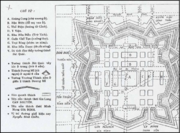
However, Pigneau found the governor of Pondicherry unwilling to further fulfill the agreement. Although the Royal Council had already decided in October 1788 to endorse Conway, Pigneau was not informed until April. Pigneau was forced to use funds raised in France and enlist French volunteers. Pigneau was unaware of this duplicity. He defiantly noted: "I shall make the revolution in Cochinchina alone." He rejected an offer from the English, and raised money from French merchants in the region.
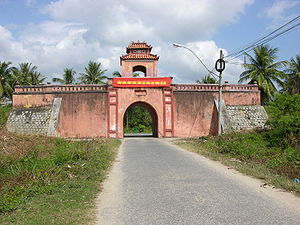
François Étienne de Rosily-Mesros
François Étienne de Rosily-Mesros was a French naval commander of the French Revolutionary Wars and Napoleonic Wars. He is notable as being chosen by Napoleon to succeed Villeneuve as commander of the combined Franco-Spanish fleet at Cádiz fleet, arriving to take up his appointment just after its...
, and another frigate to bring Pigneau back to Cochinchina.
Pigneau used the funds he had accumulated to equip two more ships with weapons and ammunition, which he named the Long phi ("Le Dragon"), commanded by Jean-Baptiste Chaigneau
Jean-Baptiste Chaigneau
Jean-Baptiste Chaigneau was a French Navy soldier and an adventurer who played an important role in Vietnam in the 19th century...
, and the Phung phi ("Le Phénix"), commanded by Philippe Vannier
Philippe Vannier
Philippe Vannier was a French Navy officer and an adventurer who went into the service of Nguyễn Ánh, the future emperor Gia Long of Vietnam.-Life:...
, and he hired volunteers and deserters. Jean-Marie Dayot
Jean-Marie Dayot
Jean Baptiste Marie Dayot was a French Navy officer and an adventurer who went into the service of Nguyễn Ánh, the future emperor Gia Long of Vietnam....
deserted the Pandour and was put in charge of supplies, transporting weapons and ammunitions on his ship the St. Esprit. Rosily, who had been commanding the Méduse deserted with 120 of his men, and was put in charge of recruitments.
Pigneau's expedition left for Vietnam on June 19, 1789, and arrived at Vũng Tàu
Vung Tàu
Vũng Tàu is a city in southern Vietnam. Its population in 2005 was 240,000. The city area is including 13 urban wards and one village. It is the capital of Ba Ria-Vung Tau province, and is the crude oil extraction center of Vietnam. It is also known as one of the most beautiful cities of tourism...
on 24 July 1789. The forces gathered by Pigneau helped consolidate southern Vietnam and modernized its army, navy and fortifications. At the highest point, the total French military presence in Vietnam seems to have consisted in about 14 officers and about 80 men.
Land forces
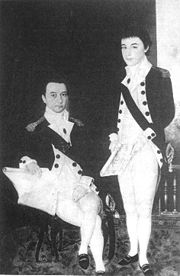
Olivier de Puymanel
Olivier de Puymanel , Nguyễn Văn Tín or Ông Tín in Vietnamese, was a French construction officer and a French Navy volunteer and adventurer who had an important role in Vietnam in the 18th and 19th century...
, a former officer of the Dryade who has deserted in Poulo Condor, built in 1790 the Citadel of Saigon
Citadel of Saigon
The Citadel of Saigon also known as the Citadel of Gia Dinh was a square Vauban stone fortress that stood in Saigon , Vietnam from its construction in 1790 until its destruction in February 1859...
and in 1793 the Citadel of Dien Khanh
Dien Khanh
Dien Khanh is a district of Khanh Hoa Province in the South Central Coastal region of Vietnam.-Dien Khanh Citadel:The Dien Khanh Citadel is situated on Dien Khanh Townlet, Dien Khanh District, Khanh Hoa Province...
according to the principles of Vauban
Vauban
Sébastien Le Prestre, Seigneur de Vauban and later Marquis de Vauban , commonly referred to as Vauban, was a Marshal of France and the foremost military engineer of his age, famed for his skill in both designing fortifications and breaking through them...
. He also trained Vietnamese troops in the modern use of artillery, and implemented European infantry methods in the Vietnamese army of Nguyễn Phúc Ánh.
In 1791, the French missionary Boisserand demonstrated to Nguyễn Ánh the usage of balloons and electricity
Electricity
Electricity is a general term encompassing a variety of phenomena resulting from the presence and flow of electric charge. These include many easily recognizable phenomena, such as lightning, static electricity, and the flow of electrical current in an electrical wire...
. Puymanel suggested that these be used to bombard cities under siege such as Qui Nhơn, but Nguyễn Ánh refused to use these contraptions.
In 1792, Olivier de Puymanel was commanding an army of 600 men who had been trained with European techniques. Puymanel is said to have trained the 50,000 men of Nguyen's army. French bombs were used at the siege of Qui Nhơn in 1793.
From 1794, Pigneau himself participated to all the campaigns, accompanying Prince Cảnh. He organized the defense of Dien Khanh
Dien Khanh
Dien Khanh is a district of Khanh Hoa Province in the South Central Coastal region of Vietnam.-Dien Khanh Citadel:The Dien Khanh Citadel is situated on Dien Khanh Townlet, Dien Khanh District, Khanh Hoa Province...
when it was besieged by a vastly more numerous Tây Sơn army in 1794.
Navy
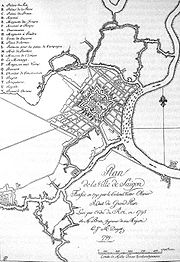
Jean-Marie Dayot
Jean Baptiste Marie Dayot was a French Navy officer and an adventurer who went into the service of Nguyễn Ánh, the future emperor Gia Long of Vietnam....
and Jean-Baptiste Chaigneau
Jean-Baptiste Chaigneau
Jean-Baptiste Chaigneau was a French Navy soldier and an adventurer who played an important role in Vietnam in the 19th century...
were used to train the navy. By 1792, a large Navy was built, with two European warships and 15 frigates of composite design.
In 1792, Dayot forced the harbour of Qui Nhơn
Qui Nhon
Qui Nhơn , also Quy Nhơn, is a coastal city in Binh Dinh province in central Vietnam. It is composed of 16 wards and five communes with a total of 286 km². Quy Nhon is the capital of Bình Định province. As of 2009 its population was 280,900. Historically, the commercial activities of the city...
, opening the way to the Cochinchinese fleet which then defeated the Tây Sơn fleet.
In 1793, Dayot led a raid in which 60 Tây Sơn galleys were destroyed.
In 1799, the Englishman Berry witnessed the departure of the Nguyễn fleet, composed of three sloops of war commanded by French officers, each of them with 300 men, 100 galleys with troops, 40 war junks, 200 smallers ships, and 800 transport boats.
Jean-Marie Dayot also did considerable hydrographic
Hydrography
Hydrography is the measurement of the depths, the tides and currents of a body of water and establishment of the sea, river or lake bed topography and morphology. Normally and historically for the purpose of charting a body of water for the safe navigation of shipping...
work, making numerous maps of the Vietnamese coast, which were drawn by his talented brother.
Arms trade
Nguyễn Ánh and Mgr Pigneau de Behaine also relied on French officers to obtain weapons and ammunitions throughout Asia through trade.In 1790, Jean-Marie Dayot
Jean-Marie Dayot
Jean Baptiste Marie Dayot was a French Navy officer and an adventurer who went into the service of Nguyễn Ánh, the future emperor Gia Long of Vietnam....
was sent by Nguyễn Ánh to Manila
Manila
Manila is the capital of the Philippines. It is one of the sixteen cities forming Metro Manila.Manila is located on the eastern shores of Manila Bay and is bordered by Navotas and Caloocan to the north, Quezon City to the northeast, San Juan and Mandaluyong to the east, Makati on the southeast,...
and Macao
Mação
Mação is a municipality in Portugal with a total area of 400.0 km² and a total population of 7,763 inhabitants.The municipality is composed of eight parishes, and is located in the Santarém District....
to trade for military supplies.
Olivier de Puymanel
Olivier de Puymanel
Olivier de Puymanel , Nguyễn Văn Tín or Ông Tín in Vietnamese, was a French construction officer and a French Navy volunteer and adventurer who had an important role in Vietnam in the 18th and 19th century...
, after having built several fortresses for Nguyễn Ánh, focused on the trading of weapons from 1795. In 1795 and 1796, he made two trips to Macao
Mação
Mação is a municipality in Portugal with a total area of 400.0 km² and a total population of 7,763 inhabitants.The municipality is composed of eight parishes, and is located in the Santarém District....
, where he sold Cochinchinese agricultural products in exchange for weapons and ammunitions. In 1795 he also travelled to Riau to trade rice received from Nguyễn Ánh. In 1797-98, he travelled to Madras to obtain the remittance of the Armida, a warship belonging to Barizy, in the service of Nguyễn Ánh, which had been seized by the British in 1797.
Barizy, who had entered the service of Nguyễn Ánh in 1793, also sailed to Malacca
Malacca
Malacca , dubbed The Historic State or Negeri Bersejarah among locals) is the third smallest Malaysian state, after Perlis and Penang. It is located in the southern region of the Malay Peninsula, on the Straits of Malacca. It borders Negeri Sembilan to the north and the state of Johor to the south...
and Pulau Pinang to exchange Cochinchinese products against weapons. His ship, the Armida was captured by the British, but finally returned. In 1800, Nguyễn Ánh sent him to trade with Madras to obtain weapons. According to one missionnary, he was:
Death of Pigneau de Behaine (1799)
Pigneau died at the siege of Qui Nhơn in October 1799. Pigneau de Behaine was the object of several funeral orations on behalf of emperor Gia LongGia Long
Emperor Gia Long , born Nguyễn Phúc Ánh , was an emperor of Vietnam...
and his son Prince Cảnh. In a funeral oration dated 8 December 1799, Gia Long praised Pigneau de Behaine's involvement in the defense of the country, as well as their personal friendship:
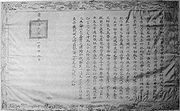
Qui Nhơn battle (1801)

On June 5, 1801, Nguyen left with his fleet for the north, and ten days later succeeded in capturing Huế
Hue
Hue is one of the main properties of a color, defined technically , as "the degree to which a stimulus can be describedas similar to or different from stimuli that are described as red, green, blue, and yellow,"...
. On 20 July 1802, Nguyễn Ánh captured Hanoi
Hanoi
Hanoi , is the capital of Vietnam and the country's second largest city. Its population in 2009 was estimated at 2.6 million for urban districts, 6.5 million for the metropolitan jurisdiction. From 1010 until 1802, it was the most important political centre of Vietnam...
and thus completed his reconquest of Vietnam.
Continued French presence in Vietnam
Once Nguyễn Ánh became emperor Gia LongGia Long
Emperor Gia Long , born Nguyễn Phúc Ánh , was an emperor of Vietnam...
, several Frenchmen remained at the court to become mandarins
Mandarin (bureaucrat)
A mandarin was a bureaucrat in imperial China, and also in the monarchist days of Vietnam where the system of Imperial examinations and scholar-bureaucrats was adopted under Chinese influence.-History and use of the term:...
, such as Jean-Baptiste Chaigneau
Jean-Baptiste Chaigneau
Jean-Baptiste Chaigneau was a French Navy soldier and an adventurer who played an important role in Vietnam in the 19th century...
. Chaigneau received the title of truong co, together with Philippe Vannier
Philippe Vannier
Philippe Vannier was a French Navy officer and an adventurer who went into the service of Nguyễn Ánh, the future emperor Gia Long of Vietnam.-Life:...
, de Forsans and Despiau, meaning second-class second-degree military mandarins, and later received the title of Grand Mandarin once Gia Long became emperor, with personal escorts of 50 soldiers.
Several also married into a Vietnamese Catholic mandarin family, such as Chaigneau, Vannier or Laurent Barizy.
The results of these French efforts at the modernization of Vietnamese forces were attested by John Crawfurd
John Crawfurd
John Crawfurd , Scottish physician, and colonial administrator and author, was born in the island of Islay, Scotland...
, who visited Huế
Hue
Hue is one of the main properties of a color, defined technically , as "the degree to which a stimulus can be describedas similar to or different from stimuli that are described as red, green, blue, and yellow,"...
in 1822:
With the death of Gia Long and the advent of Minh Mạng
Minh Mang
Minh Mạng was the second emperor of the Nguyễn Dynasty of Vietnam, reigning from 14 February 1820 until 20 January 1841. He was a younger son of Emperor Gia Long, whose eldest son, Crown Prince Canh, had died in 1801...
, relations strained considerably, and French advisors left the country. The last two of them, Jean-Baptiste Chaigneau and Philippe Vannier left Vietnam for France in 1824, together with their Vietnamese families.
Seclusion and persecutions
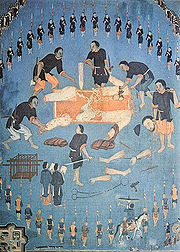
Paris Foreign Missions Society
The Society of Foreign Missions of Paris is a Roman Catholic missionary organization. It is not a religious order, but an organization of secular priests and lay persons dedicated to missionary work in foreign lands....
, remained in Vietnam, although their activities were soon prohibited and they became persecuted.
In Cochinchina, the Lê Văn Khôi revolt (1833-1835)
Le Van Khoi revolt
The Lê Văn Khôi revolt was an important revolt in 19th century Vietnam, in which southern Vietnamese, Vietnamese Catholics, French Catholic missionaries and Chinese settlers under the leadership of Lê Văn Khôi opposed the Imperial rule of Minh Mạng.-Origin:The revolt was spurred by the...
united Vietnamese Catholics, missionaries and Chinese settlers in a major revolt against the ruling emperor, in which they were defeated. Persecutions would follow, leading to the killing of numerous missionaries such as Joseph Marchand
Joseph Marchand
Joseph Marchand was a French missionary in Vietnam, and a member of the Paris Foreign Missions Society....
in 1835, Jean-Charles Cornay
Jean-Charles Cornay
Jean-Charles Cornay was a French missionary of the Paris Foreign Missions Society in Vietnam. He was born in Loudun, Vienne, France, and was executed in Ha Tay, Vietnam, during the persecutions of Emperor Minh Mạng....
in 1837, or Pierre Borie
Pierre Borie
Pierre Dumoulin-Borie was a French Catholic missionary priest and a member of the Paris Foreign Missions Society. He is a Catholic saint, canonized in 1988 along with other Vietnamese Martyrs.-Life:...
in 1838, as well as local Catholics.

Charles Rigault de Genouilly
Pierre-Louis-Charles Rigault de Genouilly was a nineteenth-century French admiral...
demanded that persecutions cease, and that Da Nang be remitted to them in application of the 1787 Treaty of Versailles
Treaty of Versailles (1787)
The Versailles Treaty of 1787 was a treaty of alliance signed between the French king Louis XVI and the Vietnamese Prince Nguyễn Ánh, the future Emperor Gia Long....
. The French sank the Vietnamese fleet in Da Nang in the Bombardment of Đà Nẵng (1847), and negotiation with Emperor Thiệu Trị
Thieu Tri
Nguyễn Phúc Miên Tông was the third emperor of the Vietnamese Nguyễn Dynasty taking the era name of Thiệu Trị...
broke down.
Persecutions of Catholics, combined with French desire for colonial expansion, would trigger ever stronger military interventions from France. The dispatch of an expeditionary force under Rigault de Genouilly would mark the return of the French military of Vietnamese soil, with the Siege of Đà Nẵng (1858) and the Capture of Saigon (1859)
Siege of Saigon
The Siege of Saigon, a two-year siege of the city by the Vietnamese after its capture on 17 February 1859 by a Franco-Spanish flotilla under the command of the French admiral Charles Rigault de Genouilly, was one of the major events of the Cochinchina campaign...
, origin of the establishment of French Indochina
French Indochina
French Indochina was part of the French colonial empire in southeast Asia. A federation of the three Vietnamese regions, Tonkin , Annam , and Cochinchina , as well as Cambodia, was formed in 1887....
.

